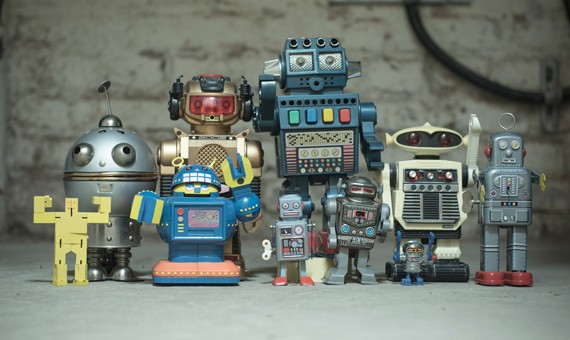Sponsored
Robotics, Smart Materials, and their Future Impact for Humans
Provided byBBVA
The nineteenth century marked the acceleration and wide adoption of industrial processes. In the twentieth century, technology moved from the laboratory and research institute to the home. We are now at the cusp of a new technological shift of equal significance: the Robotics Revolution. But what is the Robotics Revolution and what will it actually deliver?
A “robot” is often defined as a machine that can carry out a complex series of actions automatically, especially one programmable by a computer. This is a definition that encompasses a large proportion of conventional robots of the kind you see in science-fiction films. However, there is no need for a robot to be humanoid, to have limbs, to walk, or to talk. Rather, we can have a much wider interpretation of what a robot is.

The boundaries between smart materials, artificial intelligence, embodiment, biology, and robotics are blurring. This is how robotics will really affect the human race over the next twenty to forty years. From robots that can monitor and repair the natural environment to nano robots to track and kill cancer, and from robots that will lead the way to planetary colonization to robot companions to keep us from loneliness in old age. There is no part of our society or life that will not be affected by future robotics.
Instead of a conventional robot which can be decomposed into mechanical, electrical, and computational domains, we can think of a robot in terms of its biological counterpart and having three core components: a body, a brain, and a stomach. The benefit of this artificial organism paradigm is that we are encouraged to exploit, and go beyond, all the characteristics of biological organisms. And the realization of this goal is only achievable by concerted research in the areas of smart materials, synthetic biology, artificial intelligence, and adaptation.
Robotics, Smart Materials, and their Future Impact for Humans
Read Full Article
We are on the cusp of a robotics revolution in which the boundaries between artificial intelligence and biology are blurring.
A smart material is one that exhibits some observable effect in one domain when stimulated through another domain. These cover all domains including mechanical, electrical, chemical, optical, thermal, and so on. Smart materials can add new capabilities to robotics, and especially artificial organisms. You need a robot that can track chemicals? You can use a smart material that changes electrical properties when exposed to the chemical. You need a robotic device that can be implanted in a person but will degrade to nothing when it has done its job of work? You can use biodegradable, biocompatible, and selectively dissolvable polymers. Smart materials largely cover the same set of physical properties (stiffness, elasticity, viscosity) as biological tissue and state-of-the-art soft robotic technologies that have the potential to deliver this capability. Smart materials can be divided into three groups: hydraulic and pneumatic soft systems; smart actuator and sensor materials; and stiffness changing materials.
How will these robots appear in our lives and how will we interact, and live, with them? We can foresee smart skins, assist and medical devices, biodegradable and environmental robots or intelligent soft robots. For example, the compliance of soft robotics makes them ideally suited for direct interaction with biological tissue. There has been much work on smart materials for direct skin-to-skin contact and for integration on the human skin, including electrical connections and electronic components.
Similarly, for people who are frail, disabled, or elderly a future solution will be in the form of power-assist clothing that will restore mobility. Ultimately wearable assist devices will make conventional assist devices redundant. Why use a wheel chair if you can walk again by wearing soft robotic Power Pants?
Because soft robotics is so suitable for interaction with biological tissue it is also natural to think of a device that can be implanted into the body and restore the functionality of diseased and damaged organs and structures. Such bio-integrating soft robotics is under development and expected to appear in the clinic over the next ten to fifteen years.
And by exploiting smart materials that are not only environmentally safe in operation, but which safely degrade to nothing in the environment, we can realize robots that live, die, and decay without environmental damage.
Just as the impact of the internet was impossible to predict, we cannot imagine where future robotics will take us. Immersive virtual reality? Certainly. Replacement bodies? Likely. Complete disruption of lives and society? Quite possibly! As we walk the path of the Robotics Revolution we will look back at this decade as the one where robotics really took off, and laid the foundations for our future world.
Read the full article here.
Keep Reading
Most Popular
Large language models can do jaw-dropping things. But nobody knows exactly why.
And that's a problem. Figuring it out is one of the biggest scientific puzzles of our time and a crucial step towards controlling more powerful future models.
The problem with plug-in hybrids? Their drivers.
Plug-in hybrids are often sold as a transition to EVs, but new data from Europe shows we’re still underestimating the emissions they produce.
Google DeepMind’s new generative model makes Super Mario–like games from scratch
Genie learns how to control games by watching hours and hours of video. It could help train next-gen robots too.
How scientists traced a mysterious covid case back to six toilets
When wastewater surveillance turns into a hunt for a single infected individual, the ethics get tricky.
Stay connected
Get the latest updates from
MIT Technology Review
Discover special offers, top stories, upcoming events, and more.